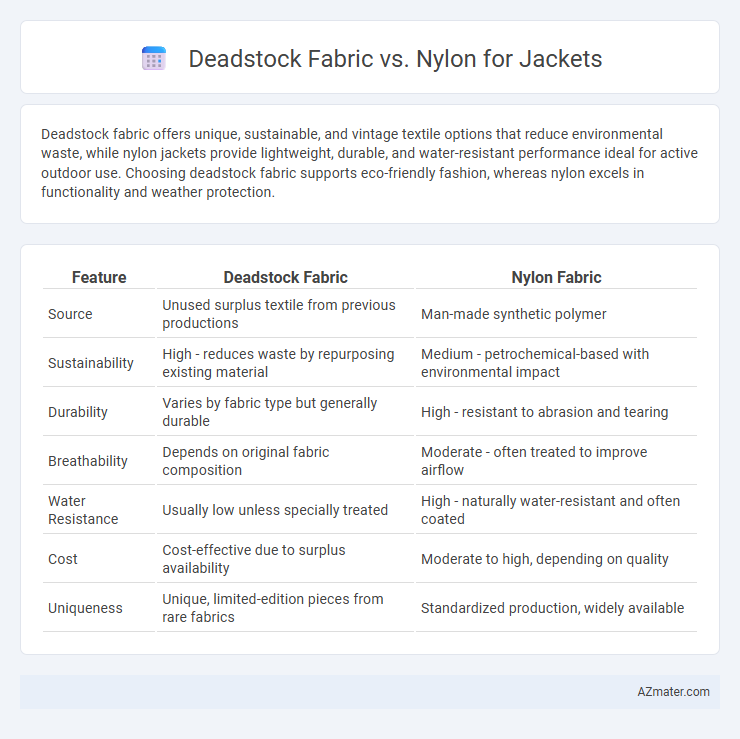Deadstock fabric offers unique, sustainable, and vintage textile options that reduce environmental waste, while nylon jackets provide lightweight, durable, and water-resistant performance ideal for active outdoor use. Choosing deadstock fabric supports eco-friendly fashion, whereas nylon excels in functionality and weather protection.
Table of Comparison
| Feature | Deadstock Fabric | Nylon Fabric |
|---|---|---|
| Source | Unused surplus textile from previous productions | Man-made synthetic polymer |
| Sustainability | High - reduces waste by repurposing existing material | Medium - petrochemical-based with environmental impact |
| Durability | Varies by fabric type but generally durable | High - resistant to abrasion and tearing |
| Breathability | Depends on original fabric composition | Moderate - often treated to improve airflow |
| Water Resistance | Usually low unless specially treated | High - naturally water-resistant and often coated |
| Cost | Cost-effective due to surplus availability | Moderate to high, depending on quality |
| Uniqueness | Unique, limited-edition pieces from rare fabrics | Standardized production, widely available |
Understanding Deadstock Fabric: Definition and Origins
Deadstock fabric refers to unused, surplus textile material from previous production runs or old inventory that has never been worn or sold. Its origins trace back to leftover fabric from fashion houses, mills, or manufacturers, often dating years or decades old, providing unique textures and vintage appeal for sustainable fashion. Using deadstock fabric in jackets promotes eco-friendly practices by repurposing high-quality, limited-quantity materials, contrasting with nylon, which is a synthetic fiber typically produced in large quantities and designed for durability and water resistance.
What Is Nylon? Key Characteristics Explained
Nylon is a synthetic polymer renowned for its exceptional strength, elasticity, and resistance to abrasion, making it a popular choice for jacket fabrication. Its lightweight nature and water-resistant properties enhance durability and comfort in various weather conditions. Unlike deadstock fabric, which is surplus material often valued for uniqueness and sustainability, nylon offers consistent performance and technical efficiency in outerwear.
Environmental Impact: Deadstock Fabric vs Nylon
Deadstock fabric significantly reduces textile waste by repurposing excess or unused materials, preventing them from ending up in landfills. Nylon production relies heavily on petrochemicals, contributing to greenhouse gas emissions and non-renewable resource depletion. Choosing deadstock fabric over nylon supports sustainable fashion by minimizing environmental impact through waste reduction and lower carbon footprint.
Durability and Longevity of Each Material
Deadstock fabric, often made from high-quality, unused surplus textiles, offers exceptional durability due to its original manufacturing standards and heavy-duty construction, making it ideal for long-lasting jackets. Nylon is renowned for its strength, resistance to abrasion, and water-repellent properties, contributing to superior longevity in jackets exposed to harsh weather conditions. Both materials provide reliable durability, but deadstock fabric excels in vintage authenticity and sustainability, whereas nylon is preferred for modern performance and weather resilience.
Comfort and Breathability: Which Wins?
Deadstock fabric often provides superior comfort due to its natural fibers and minimal chemical treatments, enhancing breathability and moisture-wicking properties. Nylon, while durable and water-resistant, typically lacks the same level of airflow and can trap heat, making it less breathable in warm conditions. For jackets prioritizing comfort and breathability, deadstock fabric generally outperforms nylon by allowing better temperature regulation and softness against the skin.
Style and Aesthetic Versatility
Deadstock fabric offers unique, vintage-inspired patterns and textures that create standout, one-of-a-kind jackets with a rich history and sustainable appeal. Nylon delivers a sleek, modern aesthetic with a smooth finish and vibrant color options, enhancing versatility in sporty and urban styles. Combining deadstock fabric with nylon elements can elevate jacket design by blending classic charm with contemporary functionality.
Cost Comparison: Deadstock Fabric vs Nylon
Deadstock fabric often costs less than nylon due to its pre-existing inventory status, reducing material expenses for jacket production. Nylon, a synthetic fiber, generally has consistent pricing driven by raw material costs and manufacturing processes, which can be higher compared to deadstock fabric's recycled or surplus nature. Choosing deadstock fabric for jackets can lead to significant cost savings while supporting sustainable fashion practices.
Availability and Sourcing Issues
Deadstock fabric offers limited availability due to its reliance on surplus or discontinued textile stock, making sourcing unpredictable and often region-specific. Nylon for jackets, sourced from synthetic fiber manufacturers, provides consistent availability and easier bulk procurement with established supply chains globally. Deadstock's unique environmental appeal contrasts with nylon's reliable supply, influencing sourcing decisions based on project scale and sustainability priorities.
Jacket Care and Maintenance Differences
Deadstock fabric jackets require delicate care to preserve their vintage fibers, often needing gentle hand washing or specialized dry cleaning to avoid damage. Nylon jackets are more durable and water-resistant, allowing for machine washing and quicker drying, simplifying maintenance. Proper storage of deadstock garments in cool, dry conditions prevents fiber degradation, while nylon jackets benefit from minimal care precautions due to their synthetic resilience.
Which Is Better for Sustainable Fashion?
Deadstock fabric, made from surplus or unused textile inventory, reduces waste by repurposing materials that would otherwise be discarded, making it a highly sustainable choice for jackets. Nylon, although durable and lightweight, is a synthetic material derived from petrochemicals and has a significant environmental footprint due to non-biodegradability and energy-intensive production. For sustainable fashion, deadstock fabric outperforms nylon as it promotes circularity and minimizes resource consumption, aligning with eco-conscious production goals.

Infographic: Deadstock Fabric vs Nylon for Jacket
 azmater.com
azmater.com